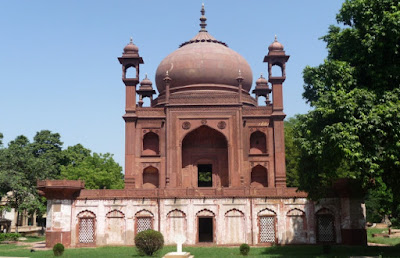famous all over the world as a symbol of eternal love. In Agra, there is the Hessing Tomb,
popularly called the Red Taj Mahal for its resemblance to the white marble Mausoleum. Like the
Taj, the Red Taj is also a symbol of love, though it is unknown to many people. Hence, it finds
no place in the itinerary of tourists to Agra.
The Tomb although almost forgotten today, provides us insight into an era when
European mercenaries and adventurers came to seek work in India and rose through the ranks.
John William Hessing was one such mercenary, hailing from the Netherlands. He arrived in
India in circa 1763, as a soldier of Dutch East India Company, but offered his services to anyone
ready to pay for it. At first, served the Nizam of Hyderabad, and later took up service under the
Marathas. In 1799 owing to his ill health, he was appointed as the Commander of the Agra Fort
by Maratha General Daulatrao Scindia. In July 1803, the English East India Company attacked
the Fort. Hessing, though seriously ill, went out to fight and perished while defending the Fort.
The Agra Fort was finally captured by the English East India Company.
Architecture:

Hessing’s wife, Anne/Alice Hessing was devastated by her husband’s death. She
commissioned this monument based on Mughal architectural style in the memory of her late
husband. The Tomb of Hessing is located inside the Old Roman Catholic Cemetery called
Padretola or Padresanto, at Nehru Nagar, in Agra.
The main mausoleum, shaped after the Taj Mahal is located atop a raised square
plinth. The Tomb is square in plan. It is 11.25 ft high and each side is 54 ft long. All four sides
are identical keeping in mind the Taj Mahal’s design. Access to the Tomb is provided by the
twin stairways on the western side of the plinth. The plinth contains rooms which may have
served as rooms for labourers and caretakers.
The exterior more or less resembles the Taj Mahal, with only the minarets
missing. Small towers, crowned by pinnacles, are attached to the central aiwan frame. Slender,
square turrets of 2 ft side are attached are attached to the four corners of the Tomb. These have
vertical flutes and are covered by beautiful square chhatris. The tomb is surrounded by dome
shaped pavilions, symbolising pride and honour. The Tomb is roofed by a double dome.
The interior is a square chamber of 17.75 ft length. At the centre there is the
cenotaph surrounded by a corridor, with ribs and panels soffit (balcony or eaves). Below the
cenotaph is a crypt with the real grave of John Hissing.
The building is entirely constructed of red sandstone, with only the plinth being
made of white marble. The double dome is crowned by a full bloomed Lotus (Padma) and pot
(Kalasha) finial. The mausoleum lacks the intricate surface decoration of the Taj Mahal.
Decoration is kept minimal. The cenotaph bears English inscriptions, which records the details
about Hessing’s life and a message from his wife.
Details about the actual builders of the Tomb have been lost in time. However, the
Tomb finds mention in the chronicles of Welsh travel litterateur Fanny Parkes, who travelled
extensively throughout India in the 19 th Century. He even visited Agra.
In spite of being forgotten and remaining invisible as a viable tourist attraction,
the Tomb of John Hessing is important for many reasons. It is the most beautiful tomb of a
European in Agra and perhaps also in India. It is perhaps the only Christian tomb in the world
built in Mughal style. Though a Dutch tomb in name, the spirit of Mughal Agra resonates
through the walls of the Tomb. Finally, the Tomb marks the continuance of the Mughal ideas,
skills and architecture well into the early 19 th Century, long after the fall of the Great Mughals.
Note to Visitors:
The Red Taj, continues to be a hidden and well-kept secret of Agra. The nearest
railway station is Agra Cantonment located 8 kms away. The nearest airport is the Agra Airport
located about 12 kms away. The Cemetery remains open between 6 am to 8 pm every day.
Bibliography:
https://timesofindia.indiatimes.com/travel/destinations/a-red-taj-in-memory-of-a-beloved-
husband/as65951165.cms
https://www.livehistoryindia.com/amazing-india/2017/04/26/the-red-taj-mahal
https://www.siasat.com/news/red-taj-mahal-husband-1401741/

Comments
Post a Comment